Staying hydrated is paramount during long hikes to sustain endurance and mental sharpness. To prevent dehydration, start by hydrating 1-2 hours prior with 16-24 ounces of water. During the hike, aim to drink 0.5 to 1 quart of water per hour, adjusting for climate and exertion. Use a mix of plain water and electrolyte drinks, and watch for dehydration indicators like dark urine. Avoid alcohol and opt for hydrating snacks such as nuts and fruits. A hydration system like a reservoir pack or accessible water bottles enhances convenience. Understanding these strategies will enhance your hiking experience safely.
Key Takeaways
- Begin hydration 1-2 hours before hiking with 16-24 ounces of water to prepare your body.
- Maintain water intake of 0.5 to 1 quart hourly, adjusting for temperature and exertion levels.
- Alternate between water and electrolyte drinks to balance hydration and replenish lost minerals.
- Monitor urine color for hydration status; light yellow indicates adequate fluid levels.
- Carry a high-capacity hydration pack or accessible water bottles for efficient hydration on the move.
Importance of Staying Hydrated
Ensuring adequate hydration during long hikes is crucial for both physical endurance and mental acuity. Proper hydration supports the body's ability to regulate temperature, maintain energy levels, and sustain muscle function.
The hydration benefits extend beyond physical health, considerably influencing cognitive performance. Dehydration can cause fatigue, reduce concentration, and impair decision-making, all of which are critical during challenging hikes. This is especially essential for seniors, who naturally have 10% less body fluid than younger individuals and often experience diminished thirst sensations, making them more susceptible to dehydration.
To maintain ideal performance, it is recommended to drink approximately 0.5 to 1 quart of water per hour while hiking. This intake should be adjusted for higher temperatures and strenuous conditions, where fluid loss is more pronounced.
The link between hydration and cognitive performance cannot be overstated—adequate fluid intake is essential to keep the mind sharp, enabling hikers to navigate difficult terrains and make sound decisions.
Pre-Hike Hydration Tips
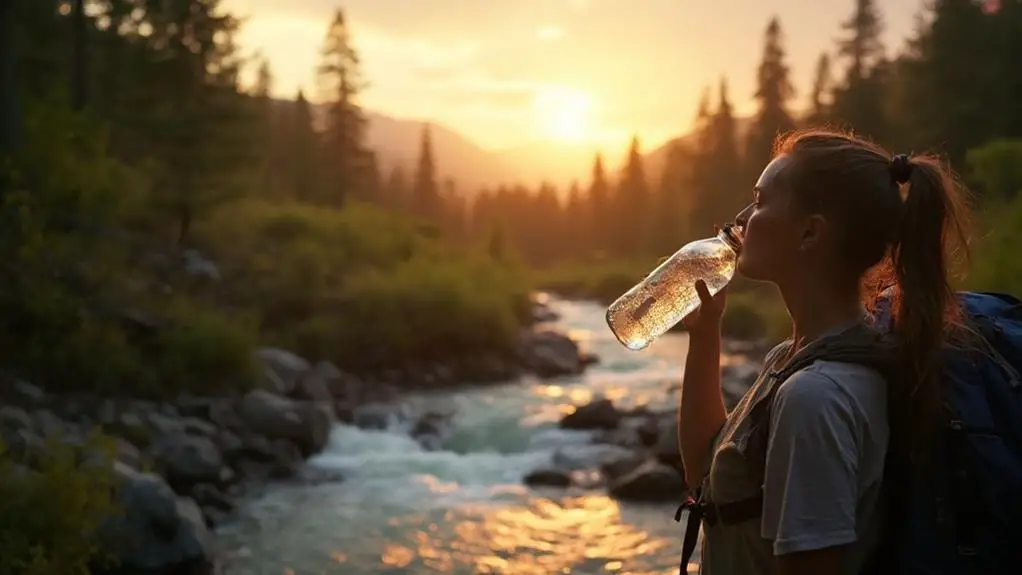
To guarantee a successful and safe hiking experience, it's essential to begin your hydration efforts well before setting foot on the trail.
Commence by drinking 16-24 ounces of water 1-2 hours prior to your hike, tailoring your hydration plan to the hike's specifics such as duration and altitude.
Prioritize packing ample water supplies, and identify potential refill points along your route, making certain you have a strategy to maintain hydration without relying solely on thirst cues.
Preparing Water Supply
Preparing adequately for hydration on a long hike is vital, as it can greatly impact your performance and safety.
Begin by evaluating your water sources and hydration gear. Knowing where you'll refill your supplies is important. Before setting out, identify streams, springs, or other reliable water sources along your route. This foresight guarantees you won't face shortages during your trek.
Regarding hydration gear, consider using a high-capacity hydration pack or water bottles that are easy to access. These tools are invaluable for maintaining a steady intake of fluids without interrupting your pace.
To guarantee ideal hydration from the onset, follow these expert guidelines:
- Pre-Hydrate: Drink 16-24 ounces of water 1-2 hours before starting. This primes your system for the physical demands ahead.
- Assess Needs: Tailor your water supply to the hike's duration, difficulty, climate, and altitude. This assessment will help you pack an appropriate amount of water for the initial stages.
- Avoid Sugary Drinks: Opt for water over sugary beverages. Sugary drinks can contribute to dehydration rather than preventing it, potentially hampering your performance and well-being.
Early Morning Hydration
A fundamental element of a successful hike starts with early morning hydration, setting the foundation for physical endurance and cognitive sharpness.
Establishing effective morning routines for hydration is essential, particularly for seniors who experience diminished thirst sensations and possess 10% less body fluid than younger adults. This demographic should be especially vigilant about their hydration habits to reduce the risk of dehydration.
Begin by consuming 16-24 ounces of water 1-2 hours prior to initiating your hike. This pre-hike hydration strategy guarantees that your body is adequately prepared for the exertion ahead.
It is important to avoid sugary drinks before your hike, as they can paradoxically lead to dehydration rather than quenching your thirst.
Consider the specifics of your hiking plan—duration, difficulty, climate, and altitude gain—when evaluating your water needs. These factors should guide how much water you should consume in the early morning.
Implementing a structured pre-hike hydration routine not only enhances your immediate hiking experience but also contributes positively to your overall fitness and health.
Avoiding Dehydration Triggers
To effectively avoid dehydration triggers during long hikes, it is essential to limit alcohol consumption before commencing your journey, as it can undermine your hydration status and increase the risk of dehydration.
Packing nutritious snacks and maintaining a balance between food and fluids are vital strategies to support energy levels and electrolyte balance throughout your hike.
Limit Alcohol Consumption
Kicking off your hike with alcohol in your system can be a recipe for dehydration disaster. The alcohol effects are twofold: it does not contribute to your hydration needs and instead promotes fluid loss through increased urination.
This is particularly concerning for seniors, who need to observe senior precautions due to inherently higher risks of dehydration from reduced body fluid and a diminished thirst sensation. Significantly, alcohol can impair judgment and physical performance, complicating the recognition of early dehydration signs, which is vital during strenuous activities like hiking.
To effectively manage your hydration strategy, consider the following expert tips:
- Avoid Alcohol on Hiking Days: It's advisable to skip alcohol entirely on days you plan to hike. Even moderate consumption can negatively impact your hydration levels and overall hiking experience.
- Opt for Hydrating Beverages: Choose water or electrolyte sports drinks to maintain proper hydration levels. These options support your body's fluid needs more effectively than alcohol.
- Monitor Your Fluid Intake: Keep track of how much you're drinking throughout your hike. Aim to drink small amounts frequently, rather than waiting until you feel thirsty.
Pack Nutritious Snacks
Packing nutritious snacks is an essential strategy for staying hydrated and energized during long hikes. Selecting the right snack variety can greatly impact your electrolyte balance and overall hydration. Prioritize snacks rich in sodium and potassium, such as nuts and dried fruits. These options help replenish electrolytes lost through sweating, a common occurrence during extended physical activity.
Incorporating complex carbohydrates, like whole grain crackers, is another practical tip to guarantee sustained energy without the dehydration risk associated with sugary snacks.
Individually wrapped energy bars offer a convenient and practical solution for maintaining your energy levels. They are easy to pack, and their balanced nutrient content supports prolonged exertion. However, be mindful to avoid alcohol before and during hikes, as it can exacerbate dehydration and hinder physical performance.
To enhance hydration and energy, consider preparing a diverse selection of snacks that cater to both taste and nutritional needs. This approach not only improves the hiking experience but also safeguards against dehydration-related illnesses.
Balance Food and Fluids
Balancing food and fluids during long hikes is crucial to maintaining hydration and preventing dehydration triggers. To guarantee ideal fluid absorption and electrolyte balance, hikers should adhere to a strategic approach combining regular hydration and nutrient intake. Aim to consume 0.5 to 1 quart of water per hour of hiking, which aids in preventing dehydration and supports fluid absorption.
- Electrolyte-Rich Snacks: Incorporate snacks high in sodium and potassium, such as nuts, energy bars, or bananas, to replenish electrolytes lost through sweat. These nutrients are essential for maintaining the body's electrolyte balance, especially during prolonged physical activities.
- Alcohol Avoidance: Refrain from consuming alcohol before and during hikes. Alcohol acts as a diuretic, reducing the body's water levels and exacerbating dehydration, which undermines efforts to maintain fluid absorption.
- Routine Intake: Establish a routine of frequent food and fluid intake. This practice not only supports sustained energy levels but also mitigates the risk of illness associated with dehydration.
Opt for individually wrapped snacks for convenience, guaranteeing you have accessible nutrition throughout your journey.
Hydration During the Hike
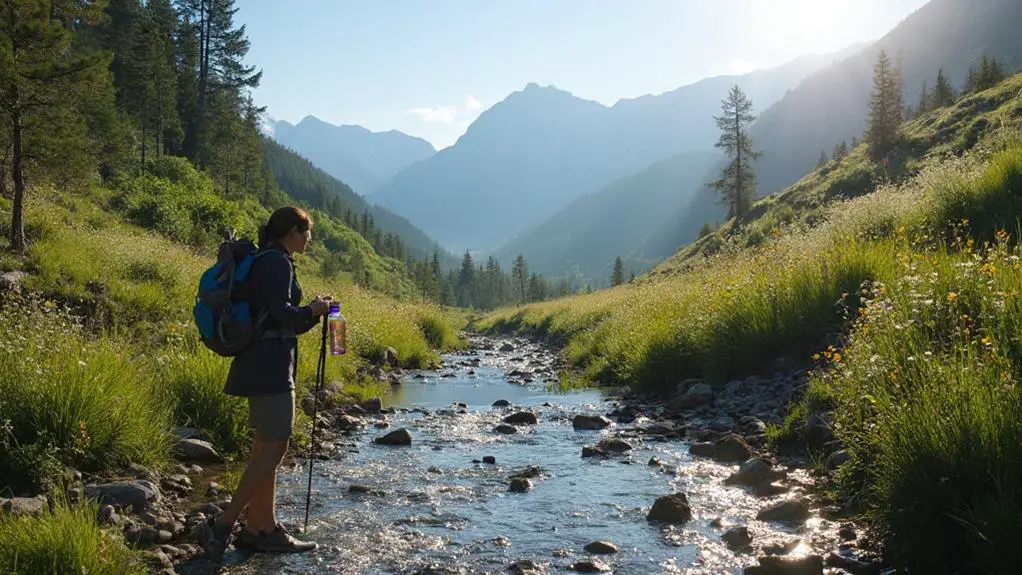
While starting a long hike, maintaining proper hydration is essential to guarantee endurance and overall well-being. Employing effective hydration strategies is fundamental, particularly in varied environmental conditions. A foundational approach to water intake involves consuming 0.5 to 1 quart per hour. This should be adjusted according to temperature and exertion levels. Remember, thirst is often a delayed signal; hence, regular sips of water are critical before reaching the point of thirst.
A balanced approach to hydration involves alternating between plain water and electrolyte sports drinks. This helps maintain the body's electrolyte balance, fundamental for muscle function and preventing cramps. Regular monitoring of your hydration status can be done by checking urine color; a light yellow hue indicates adequate hydration.
| Hydration Guide | Recommendations |
|---|---|
| Water Intake | 0.5-1 quart/hour |
| Daily Minimum | 1.5 liters (1.6 quarts) |
| Electrolyte Balance | Alternate with sports drinks |
| Hydration Indicator | Light yellow urine |
Staying aware of these hydration practices guarantees that your energy levels remain stable, reducing the risk of dehydration-related fatigue. By prioritizing regular water consumption and staying attuned to bodily signals, hikers can make the most of their outdoor adventure.
Post-Hike Rehydration
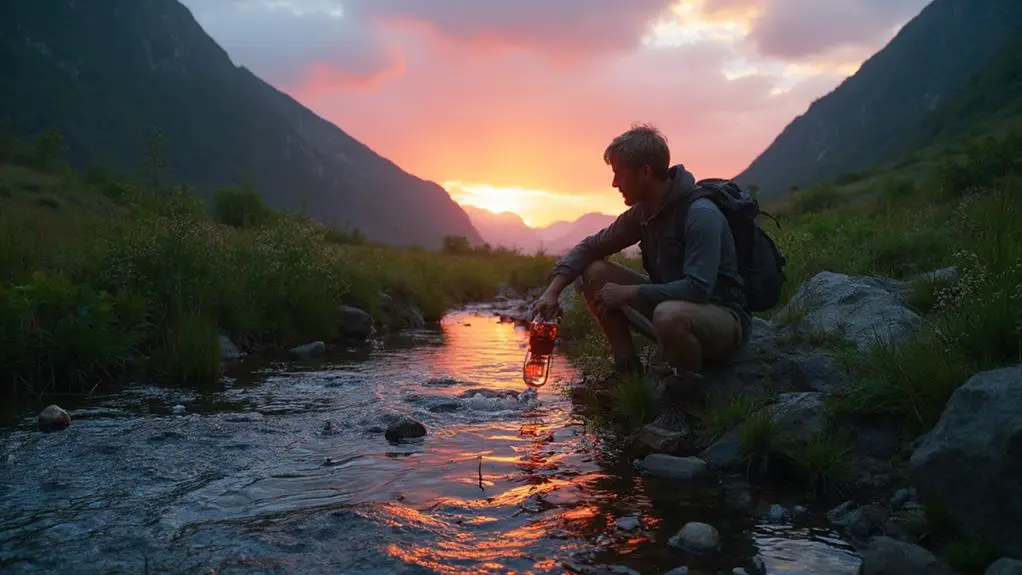
Completing a long hike signals the start of the recovery phase, where post-hike rehydration becomes a priority to restore fluid balance and promote recovery.
Adequate rehydration strategies are vital after exertion, as the body needs to replenish an additional 1-2 liters of water to achieve ideal hydration levels. Thirst can often underestimate actual needs, therefore being proactive with fluid intake is advised.
Here are some practical tips to guarantee effective post-hike rehydration:
- Monitor Urine Color: Aim for light yellow urine to gauge proper hydration. Darker shades suggest the need for additional fluid intake. This simple hydration reminder acts as an excellent self-check mechanism.
- Utilize Oral Rehydration Salts: In cases of pronounced dehydration, oral rehydration salts can greatly enhance fluid absorption, offering a quicker path to recovery. These salts can be mixed with water to help restore the body's equilibrium effectively.
- Consume Electrolyte-Rich Options: Post-hike, integrating electrolyte-rich drinks or snacks helps in restoring the balance lost through sweat. This not only aids in hydration but also supports muscle function and prevents cramping.
Incorporating these strategies will guarantee a well-rounded approach to post-hike rehydration, promoting ideal recovery and well-being.
Choosing a Hydration System
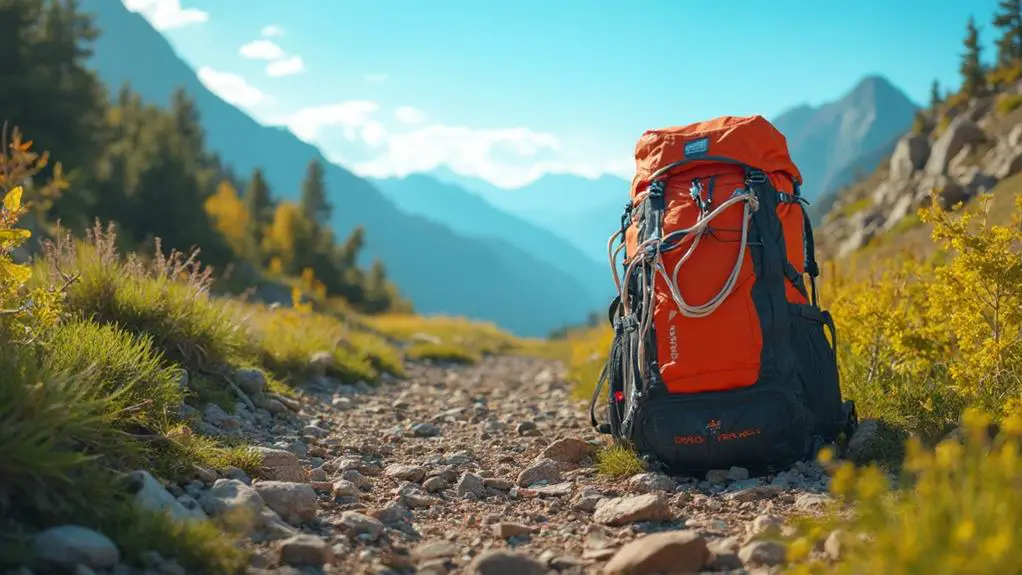
Selecting an appropriate hydration system is a critical component of successful long-distance hiking, guaranteeing that you can maintain ideal fluid intake without interrupting your pace. Advancements in hydration technology have provided hikers with versatile options to efficiently manage water intake.
Hydration reservoir packs are particularly favored for their hands-free drinking capability, allowing hikers to sip without halting their stride. These systems also promote maximum weight distribution, minimizing the strain on your back during extended treks.
For those who prefer traditional methods, classic water bottles remain a reliable choice. Verify they are placed in accessible mesh pockets on your backpack for quick access, preventing unnecessary delays. Alternatively, soft flasks can be attached to shoulder straps, offering the advantage of visible water levels and easy sips without removal.
Weight considerations are paramount when selecting your hydration system. Carrying a compact water purification system, such as filters or tablets, can alleviate the burden of transporting large water volumes by allowing you to safely refill from natural sources.
When making your choice, consider the hike's duration, available refill points, and personal preferences to balance accessibility with weight efficiency. This strategic approach will support continuous hydration and enhance your hiking experience.
Recognizing Dehydration Signs

Recognizing the early signs of dehydration is vital for ensuring safety and performance during long hikes. Developing hydration awareness can prevent mild dehydration symptoms from escalating into severe conditions. Early signs to watch for include increased thirst, dry mouth, and a noticeable decrease in energy levels. These symptoms indicate the body's urgent need for fluids and should prompt immediate rehydration.
To effectively monitor hydration status, hikers should consider the following practical tips:
- Urine Color Monitoring: A reliable indicator of hydration levels is urine color. Light yellow suggests adequate hydration, while darker shades warn of dehydration. Regular monitoring can help hikers adjust their fluid intake accordingly.
- Weight Monitoring: Weighing oneself before and after a hike can help identify fluid loss. A significant decrease in weight signals the need to replenish lost fluids promptly to maintain peak performance and prevent dehydration symptoms.
- Awareness of Severe Symptoms: Severe dehydration can manifest as muscle cramps, dizziness, headaches, and dark-colored urine. In extreme cases, confusion or disorientation may occur, underscoring the important need for consistent hydration.
Prompt recognition and response to these dehydration symptoms are essential for maintaining health and safety during rigorous outdoor activities.
Preventing Overhydration
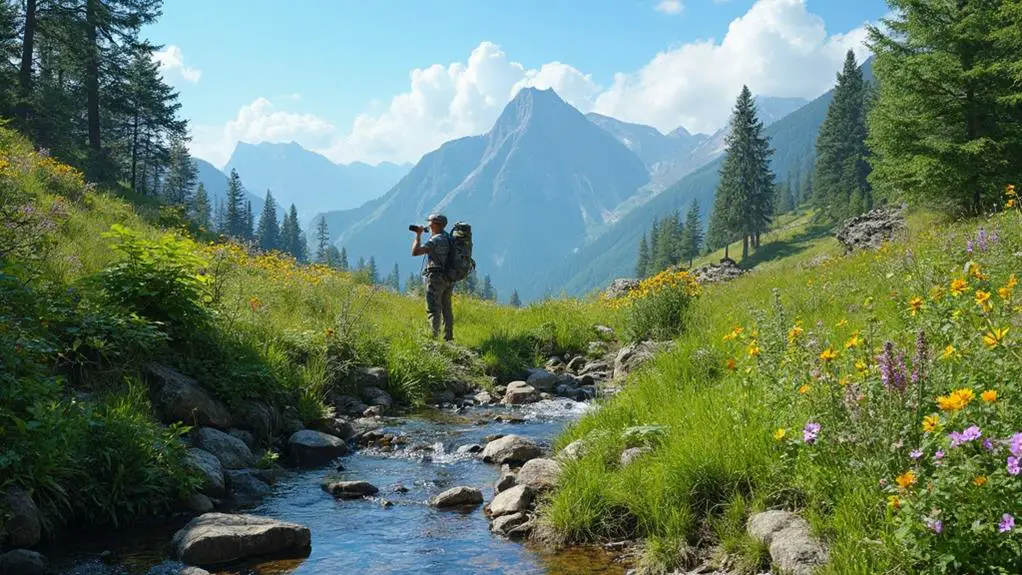
How can hikers strike the right balance between hydration and overhydration during long hikes? Achieving this equilibrium involves careful monitoring of water intake and sodium balance. Overhydration, or hyponatremia, can occur when excessive water dilutes blood sodium levels, causing fatigue, headache, and nausea. To prevent this, hikers should aim for a water intake of about 10 fl. oz. every 20 minutes, ensuring that drinking aligns with sweat loss rather than exceeding it.
Maintaining sodium balance is equally important. Sodium is lost through sweating, and without replenishment, it can lead to imbalances. Consuming salty snacks or electrolyte drinks can compensate for this loss, helping to stabilize sodium levels and prevent overhydration.
Additionally, evaluating urine color and volume provides valuable insights; large amounts of clear urine can indicate excessive water consumption.
Another key strategy involves monitoring weight loss post-hike. Significant weight reduction often signals fluid loss, but if this is not accompanied by dehydration symptoms, it may necessitate revising hydration strategies to prevent overhydration.
Frequently Asked Questions
How to Get Water on a Long Hike?
To obtain water on a long hike, plan your route to find natural sources. Utilize water purification methods like portable purifiers or tablets. Employ portable water containers, such as hydration bladders, for efficient water storage and access.
How Much Water Should I Take on a Long Hike?
For long hikes, balance water weight with hydration needs by carrying at least 1.5 liters daily, adjusting for exertion and climate. Expert hydration tips include pre-hike hydration and monitoring urine color to guarantee ideal fluid intake.
What Is the Best Drink for Long Walks?
The best drink for long walks combines electrolyte balance and effective hydration strategies. Water remains essential, complemented by electrolyte sports drinks or homemade solutions to replenish sodium and potassium, ensuring sustained energy and ideal hydration during extended physical activity.
How Much Water Should I Drink on a 5 Mile Walk?
For ideal hydration on a 5-mile walk, consider these hydration tips: consume 16-32 ounces of water, adjusting for temperature and sweat rates. Utilize reliable water sources to replenish as necessary, ensuring consistent hydration throughout your journey.
Conclusion
In summary, maintaining ideal hydration during long hikes is essential for ensuring physical performance and overall well-being. By adhering to pre-hike hydration strategies, identifying and avoiding dehydration triggers, and employing effective hydration techniques during and after the hike, hikers can sustain energy levels and prevent dehydration. Selecting an appropriate hydration system and being vigilant about signs of both dehydration and overhydration are critical. These practices not only enhance the hiking experience but also safeguard health and safety in challenging outdoor environments.